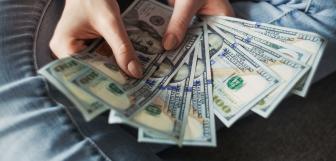Restaurant expenses: Examples of the biggest costs involved
Handling restaurant expenses every month can be a real headache. No matter if you’re a tiny dine or a big franchise, the bills don’t stop coming in.
If your place is established, busy, and the cash is flowing, you can most likely keep up with the costs. But if you're just starting out, it might take a few months to figure out all the expenses. Getting a handle on these costs is key if you want your restaurant to succeed in the long run.
Don’t worry, we’re here to help! Keep reading to find out what typical expenses look like and how you can stay on top of them.
Types of restaurant costs
Running a restaurant means dealing with a bunch of different costs. Some you can plan for, and others will catch you off guard. To make sure you're prepared, let’s break it down so you know what’s coming (and where your money’s going).
Restaurant startup costs
Starting a restaurant isn’t cheap (like, at all). In fact, a survey from Restaurant Owner found that restaurant startup costs can range anywhere between $175,500 to more than $2 million.
First, there are the rent or mortgage payments for your location. Whether you’re in a busy downtown spot or a quieter neighborhood, you’ll need to shell out some serious cash. Then there’s the cost of getting the place ready. Construction costs, new kitchen equipment, and all those little things that add up fast.
Don’t forget about licenses, permits, and insurance premiums. You’ll also need to stock up on food and drinks before opening. Plus, if you’re opening a fancy spot, everything costs more—from the decor to the plates. Marketing expenses to get the word out? Yep, include those too.
The bottom line is that starting up is expensive, but it’s what gets your restaurant off the ground. So, plan carefully and maybe keep a stress ball handy.
Fixed costs
Fixed costs are the bills that hit you every month, no matter what. These include your rent or mortgage payments, utility costs, and insurance premiums. Payroll taxes and salaries for your full-time staff are also in this mix. No escaping those.
Fixed costs are pretty predictable, but they still add up. You need to budget you restaurant costs carefully so they don’t sneak up on you. If you can keep these restaurant costs under control, you’ll have a much easier time staying profitable. And if you’re lucky, you might even have some cash left for, you know, yourself.
Variable costs
Variable costs change based on how busy your restaurant is. The biggest one? Food costs. When more customers come in, you need more ingredients. Keeping your food cost percentage low is crucial if you want to stay in the black. Smart inventory management helps here—buy too much, and you’re throwing money away on spoiled food. Buy too little, and you’ll run out of stuff mid-rush.
Labor costs are also a big part of your variable expenses. The more customers, the more hourly workers you’ll need on the clock. And don’t forget about marketing costs. If you’re running a promotion or launching a new menu item, you might spend more on advertising. Because social media posts don’t always cut it.
The key to managing your fixed and variable costs is to stay on top of them. Adjust your schedules, tweak your menu prices, and always keep an eye on the bottom line.
Unexpected costs
Ah, the fun part—unexpected costs. No matter how much you plan, something will always come up. Maybe the oven breaks down, or your utility costs suddenly spike. (Thanks, summer heat.) These are the costs that hit you when you least expect it, and they can throw a wrench in your budget.
Unexpected labor expenses might pop up too. Think minimum wage hikes or losing a key employee (so long, experienced chef). Let’s not forget those surprise regulatory changes that force you to upgrade your equipment or re-do something in your restaurant.
The best way to handle these curveballs? Set aside some cash each month for a rainy day. (Or a rainy month.) That way, when something unexpected happens, you won’t be scrambling to cover the costs. It’s all part of the rollercoaster that is running a restaurant. Hold on tight!
5 most common restaurant expenses list
Here are five restaurant monthly expenses you can expect to see, and why they matter.
Food and beverage expenses
Every profitable restaurant knows its food costs inside and out. Tracking ingredient prices is key, and modern restaurants use tools like invoice automation to keep up with those ever-changing costs. Once you’ve got your ingredient prices under control, you can move on to recipe costing and then plate costing, which helps you keep track of your cost of goods sold (COGS).
This data lets you set smart menu prices and target the right food cost percentage. While the industry average hovers around 30%, your ideal percentage might be different. Figuring this out is crucial for staying profitable.
Labor costs
Labor costs are another biggie, and there are a few ways to calculate them: as a labor cost percentage of sales, a percentage of total costs, or hourly wages. Most folks use the percentage of sales method, with the industry average being about 30%. But just like with food costs, your labor costs will vary depending on your restaurant concept, the steps of service, and even the location.
Getting a handle on labor expenses is all about finding the right balance for your operation. Keeping an eye on your labor cost percentage is essential for managing your payroll and staying in the black.
Equipment expenses
Takeout and delivery are huge these days, which means you’re probably spending a lot on carryout materials. Things like to-go containers, bags, and plastic cutlery are now regular monthly expenses that can’t be ignored—especially if takeout is a big part of your business.
You’ve also got other equipment such as:
-
Kitchen equipment: Ovens, stoves, fridges, freezers, dishwashers, and more.
-
Cooking gear: Pots, pans, cutting boards, pasta cookers, strainers, ladles, and all the essentials.
-
Workstations: Counters, prep tables, steam tables, and cold food tables.
-
Bar tools: Mixers, cocktail shakers, ice machines, and other bar essentials.
-
Service items: Serving trays, plates, tablecloths, utensils, glassware, and everything for the dining experience.
Smart operators roll these costs into their plate costs, adjusting their food cost percentages to include the expense of these non-food items.
Restaurant operational costs
Operational costs cover everything it takes to keep your restaurant running day-to-day. This includes your rent or mortgage, utility bills, insurance premiums, and even property taxes. These are the fixed and variable expenses that are part of running any restaurant.
Operational costs might not be the most exciting part of the job, but they’re essential for keeping the doors open. Careful budgeting and monitoring of these expenses will help you stay on top of your game and keep your restaurant profitable.
Marketing for your restaurant business
"Build it and they will come" sounds great, but it’s not quite that easy. Your new restaurant needs some marketing magic to get people through the doors, both on opening day and beyond.
Remember to budget restaurant marketing strategy and PR activities. Many new restaurant owners skip this, but it’s crucial. You’ll need someone to set up your website, design your logo, handle social media, manage customer reviews, and work with influencers.
If you’re running on a tight budget, social media and digital ads are your best friends. They’re affordable and can reach a lot of people—promoted posts might cost just a few hundred bucks.
Make sure your restaurant has a slick website that works well on mobile devices, and that all your online content is top-notch and SEO-friendly. If writing isn’t your thing, hiring a freelancer can be a good deal—usually around $500 or less. Don’t forget to list your restaurant in local directories and review sites to build up your reputation.
If you want to go old-school with radio or TV ads, be ready to spend more. Radio ads typically cost $20 to $80 per spot, and TV ads can run between $200 to $1,500 for a 30-second local spot.
Strategies to control your monthly restaurant expense management
Managing your restaurant's monthly expenses doesn’t have to feel like herding cats. With a few smart strategies, you can keep those costs in check and even boost your profits. Here are some practical tips to help you take control and stay ahead of the game.
Advanced menu planning to optimize profits
Your menu is more than just a list of dishes—it’s one of your best tools for managing costs and maximizing profits. Advanced menu planning is all about knowing your numbers. Start by diving into your recipe costing and plate costing. Know exactly what each dish costs to make and what you’re charging for it.
Once you’ve got a clear picture, look at how your most popular dishes are performing. Are they bringing in the profits, or just covering costs? If some items aren’t pulling their weight, it might be time to swap them out for something more cost-effective. And don’t forget about portion control—keeping portions consistent helps keep food costs steady.
Another trick? Create dishes that share ingredients. This cuts down on waste and lets you buy in bulk, which can save you money. Menu planning isn’t just about what’s on the plate—it’s about making sure every item helps your bottom line.
Adjust your restaurant pricing to remain competitive
Pricing is a balancing act. You want to cover your costs and make a profit, but you also need to keep prices reasonable so customers keep coming back. Start by reviewing your food and labor costs regularly. If ingredient prices go up or you’re facing higher labor costs, you might need to adjust your menu prices to keep your margins healthy.
But it’s not just about raising prices. Sometimes, a small price drop can boost sales enough to increase overall profits. Keep an eye on what your competitors are doing, too. You don’t want to be the most expensive place in town unless you’re offering something truly special.
Consider offering tiered pricing—like small, medium, and large portions—to appeal to a broader range of customers. And don’t be afraid to experiment with pricing for new items or special promotions. Just be sure to track the results so you know what’s working.
Implement point of sale technology to automate processes
Running a restaurant involves juggling a lot of tasks, but with the right technology, you can make things a whole lot easier. Implementing a modern point of sale system can automate many of your processes, saving you time and reducing human error.
A good POS system does more than just ring up sales, it can help with everything from managing inventory to tracking employee hours and monitoring sales trends. By automating these tasks, you the restaurant owner, can free up your staff to focus on what they do best: serving your customers.
Plus, a POS system can give you real-time insights into what’s selling and what’s not. This data is gold when it comes to making decisions about menu changes, staffing, and promotions. And let’s not forget about the added convenience for customers, who appreciate fast, accurate service.
Cut down food cost with smart ordering systems
Food costs can eat into your profits if you’re not careful. One way to keep them in check is by using a smart ordering system. These systems help you track inventory in real time, so you know exactly what you have on hand and what you need to order. This prevents over-ordering (which leads to waste) and under-ordering (which leads to disappointed customers).
Smart ordering systems can also suggest orders based on historical data, helping you buy just the right amount of each ingredient. Some systems even integrate with your point of sale management software, so you can see which items are selling fast and need to be restocked.
Another tip? Build relationships with your suppliers. They can offer you insights into price fluctuations and might even cut you a deal if you’re a regular, reliable customer. The goal is to stay ahead of the game so you’re always stocked up without overspending.
Monitor your financial performance through real-time reports
You can’t manage what you don’t measure. Monitoring your financial performance through real-time reports gives you the information you need to make smart decisions on the fly. Most modern restaurant POS systems come with reporting features that let you track sales, costs, and profits in real time.
These reports can show you which menu items are making money and which ones are costing you. You can also see labor costs in relation to sales, helping you adjust staffing levels to avoid overpaying during slow times. By keeping an eye on your food cost percentage, you can make sure you’re not letting waste or price increases eat into your profits.
The best part is that you don’t need to be a financial wizard to use these reports. They’re designed to be user-friendly, so you can quickly spot trends and take action. Staying on top of your financial performance means fewer surprises and more control over your restaurant’s success.
FAQ about restaurant costs
- How expensive is it to open a restaurant?
-
Opening a restaurant can cost anywhere from $100K to $1 million, depending on the location, concept, and size. For example fine dining establishments in the restaurant industry will likely be on the upper side of that. Expect to shell out for everything, rent, kitchen equipment, permits, and initial inventory. The final price tag varies, depending on your restaurant fixed costs and variable costs of a restaurant, but it’s definitely not cheap.
- What are the direct costs in a restaurant business?
-
Direct costs are the ones directly tied to what you serve, like food, beverages, and labor. These include what you pay for ingredients, hourly wages for staff, and any packaging for take-out. They’re the biggest chunk of your monthly expenses.
- What is the 50/30/20 rule?
-
The 50/30/20 rule is a budgeting guideline: 50% of your budget goes to fixed costs (like rent and utilities), 30% to variable costs (like food cost of a restaurant and labor), and 20% to savings or profit. It’s a simple way to keep your kitchen expenses balanced.
- What is the best costing method for restaurants?
-
The best costing method for restaurants is recipe costing, which calculates the exact cost of each dish on your menu. It helps you set prices that cover your costs and generate profit. Combine it with plate costing for even better control.
- How do restaurants maintain costs?
-
Restaurants maintain costs by tracking expenses, adjusting menu prices, monitoring labor, and using technology to streamline operations. Smart inventory management, regular financial reports, and advanced menu planning also help keep costs in check. It’s all about staying on top of the numbers.




